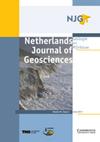荷兰Winterswijk的雷蒂亚(晚三叠世)鱼类遗骸(双鱼座:软骨鱼科和放线鱼科)
IF 2.3
2区 地球科学
Q3 GEOSCIENCES, MULTIDISCIPLINARY
Netherlands Journal of Geosciences-Geologie En Mijnbouw
Pub Date : 2023-01-01
DOI:10.1017/njg.2023.10
引用次数: 0
摘要
摘要描述了在Winterswijk采石场的Rhaetian(约208.05-201.36 Ma)或Norian晚期沉积物中发现的软鱼目和放光鳍目鱼类遗骸。最丰富的分类群是放线翼类的Gyrolepis albertii,其次是软骨鱼类的Lissodus minimus。此外,还发现了古翼鱼目长尾龙目(sauurichthys longidens)和尖齿龙目(Birgeria acuminata),新翼鱼目(Sargodon tomicus)、Lepidotes sp.和不确定的pycnodontiforms,以及Rhomphaiodon minor、Parascylloides turnerae和一些Hybodus c.s cuspidatus (H. cloacinus的高级同义词)。此外,还发现了软骨鱼的真皮小齿、放线鱼的鳞片和鳃耙、牙板和一些鱼骨。在动物群上,与英国Penarth群的Rhaetian有相当大的相似之处,尽管这取决于样本中是软骨鱼类还是放线鱼类的位置。平均而言,在英国的样本中,软骨鱼类的牙齿比放射线翼龙的牙齿要多,这与温特斯韦克的情况相反。这也许可以用不同的生态环境来解释,比如温特斯韦克(Winterswijk)水底的含氧量较低,以及英国淡水输入和/或盐度的变化。本文章由计算机程序翻译,如有差异,请以英文原文为准。
Fish remains from the Rhaetian (Late Triassic) of Winterswijk, the Netherlands (Pisces: Chondrichthyes and Actinopterygii)
Abstract Chondrichthyan and actinopterygian fish remains from Rhaetian (c. 208.05–201.36 Ma) or perhaps Late Norian deposits in the Winterswijk quarry are described. The most abundant taxon is the actinopterygian Gyrolepis albertii , followed by the chondrichthyan Lissodus minimus . Furthermore, the palaeopterygian actinopterygians Saurichthys longidens and Birgeria acuminata , and some teeth of neopterygians Sargodon tomicus , ‘ Lepidotes ’ sp. and indeterminate pycnodontiforms are recorded in addition to the chondrichthyans Rhomphaiodon minor , Parascylloides turnerae and some ‘ Hybodus ’ cf. cuspidatus (senior synonym of H. cloacinus ). Chondrichthyan dermal denticles, actinopterygian scales and gill rakers, tooth plates, and some fish bones were also found. There is considerable faunal resemblance to the various localities from the Rhaetian of the British Penarth Group, although it depends on the location as to whether chondrichthyans or actinopterygians prevail in the samples. On average, there are more chondrichthyan teeth present in the British samples than actinopterygian teeth, which is opposite to the situation in Winterswijk. That might be explained by different ecological circumstances, such as lower oxygen levels in bottom waters in Winterswijk and freshwater input and/or changes in salinity in the UK.
求助全文
通过发布文献求助,成功后即可免费获取论文全文。
去求助
来源期刊
CiteScore
4.00
自引率
25.90%
发文量
14
审稿时长
>12 weeks
期刊介绍:
Netherlands Journal of Geosciences - Geologie en Mijnbouw is a fully open access journal which publishes papers on all aspects of geoscience, providing they are of international interest and quality. As the official publication of the ''Netherlands Journal of Geosciences'' Foundation the journal publishes new and significant research in geosciences with a regional focus on the Netherlands, the North Sea region and relevant adjacent areas. A wide range of topics within the geosciences are covered in the journal, including "geology, physical geography, geophyics, (geo-)archeology, paleontology, hydro(geo)logy, hydrocarbon exploration, modelling and visualisation."
The journal is a continuation of Geologie and Mijnbouw (published by the Royal Geological and Mining Society of the Netherlands, KNGMG) and Mededelingen Nederlands Instituut voor Toegepaste Geowetenschappen (published by TNO Geological Survey of the Netherlands). The journal is published in full colour.

 求助内容:
求助内容: 应助结果提醒方式:
应助结果提醒方式:


